Configuration Menu
These menus contain the set of configuration settings for GNSS Compass.
Sensor Ranges
The Sensor Ranges page is used to set the dynamic range of the sensors. If you are experiencing over-range events during operation, these settings should used to increase the range of the sensor which is reporting the over-range. The lowest ranges give the best performance, so make changes slowly and monitor the results.

GNSS Compass Web UI Sensor Ranges Page
Filter Options
Ensure that the Vehicle Type filter option is selected for all applications. For most standard applications, the other filter options can be left as their defaults.
See Filter Initialisation for more information on these specific settings. If you require assistance, contact support@advancednavigation.com.

GNSS Compass Web UI Filter Options Page
Data Ports
The Data Ports page allows you to specify which data packets or messages are output on a periodic basis and at what rate via a range of serial and Ethernet ports.
By default NMEA0183 is output over Ethernet. See NMEA 0183 for details on messages and output rates.
Other data formats available include NMEA0183, GNSS, TSS1, SIMRAD and other formats. For more information see Ethernet Functions.
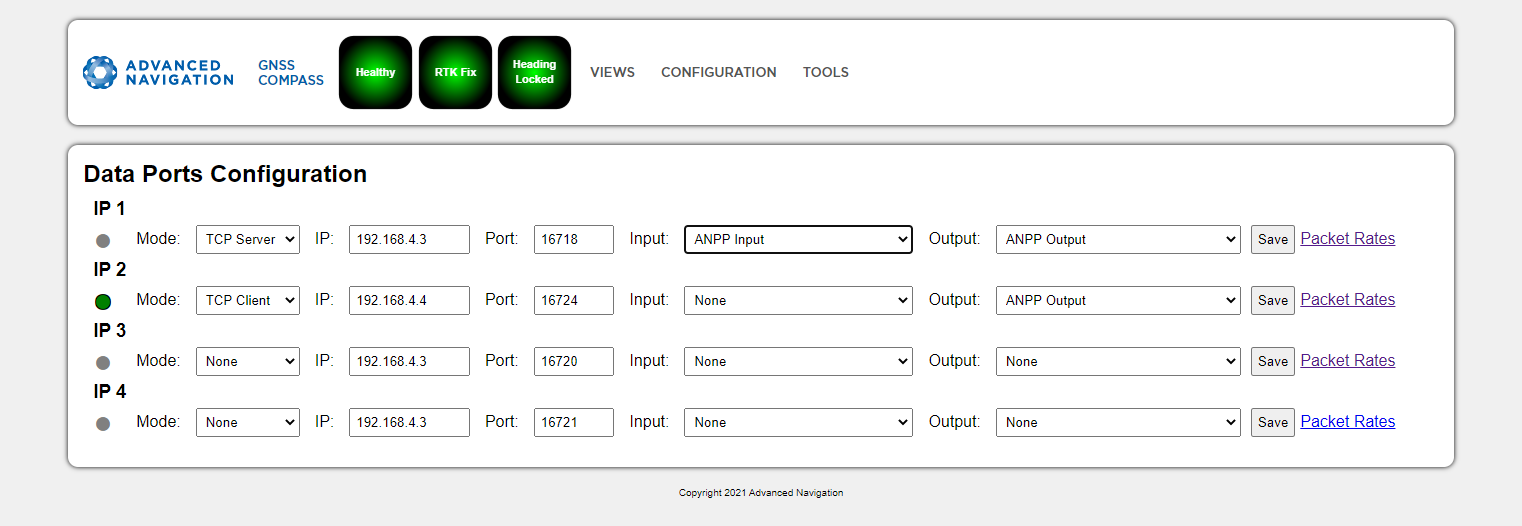
GNSS Compass Web UI Data Ports Page
Alignment
The Alignment page is used to set the alignment offsets of the system installation. It is important to set the values on this page correctly to avoid degrading performance.
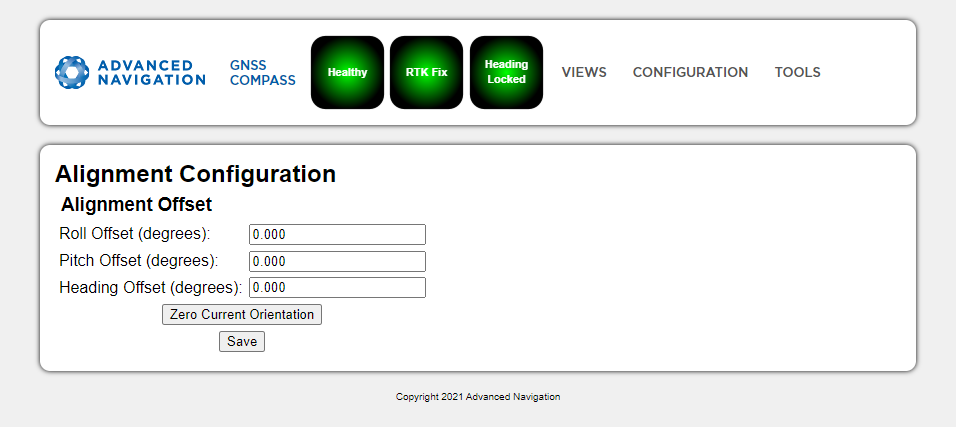
GNSS Compass Web UI Alignment Page
Alignment Offset
If GNSS Compass is installed into the vehicle with the positive X axis pointing forwards and the positive Z axis pointing down, then no alignment offset is required and the roll, pitch and heading offset values can remain at the factory defaults of zero.
If the unit is installed in a different orientation then the roll, pitch and heading offset must be entered. For example, if the unit is installed on its side with the X axis pointing up and the Z axis pointing forwards and no change to the Y axis, then this would result in a pitch offset of +90 degrees with roll and heading remaining zero.
If there is a small misalignment due to mechanical mounting error this can be compensated for by setting the vehicle stationary on a level surface and clicking the Zero Current Orientation button.
Note: Zero Current Orientation will only correct for roll and pitch offsets, the Heading offset must be entered manually and saved after using this function.
Reset
The Reset button causes the system to perform a power cycle. No configuration settings or state data are lost.
The Cold Start button clears all filters, and connections are reset and must re-established. No configuration settings are lost.
The Factory Reset button resets all GNSS Compass settings back to their factory defaults, including state data and all configuration settings. It also erases the hot start data so that the system is forced to perform a cold start.
Note: A Factory Reset will re-enable the DHCP Client and lose any static IP address settings.

GNSS Compass Web UI Reset Page
Manual Initialisation
This page can be used to manually initialise GNSS Compass when a GNSS fix is not available. Setting the position will initialise the navigation filter. Setting the heading will also initialise the heading filter.
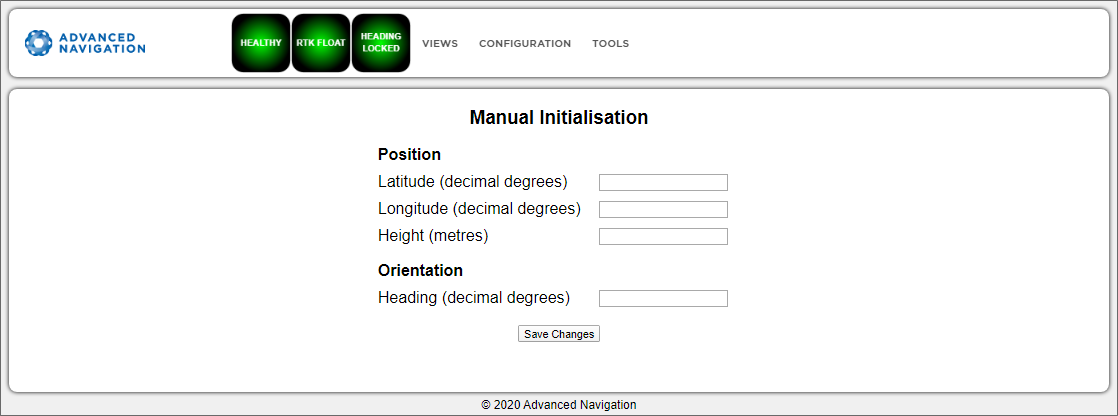
GNSS Compass Web UI Manual Initialisation Page
Ethernet Settings
The Ethernet Settings page allows you to enable or disable the DHCP Client. When the DHCP Client is disabled you need to enter the TCP/IP settings if you wish to access the web UI.
If you are only connecting to GNSS Compass via the primary port these settings can be ignored.
The default is for the Ethernet mode to be set to DHCP.
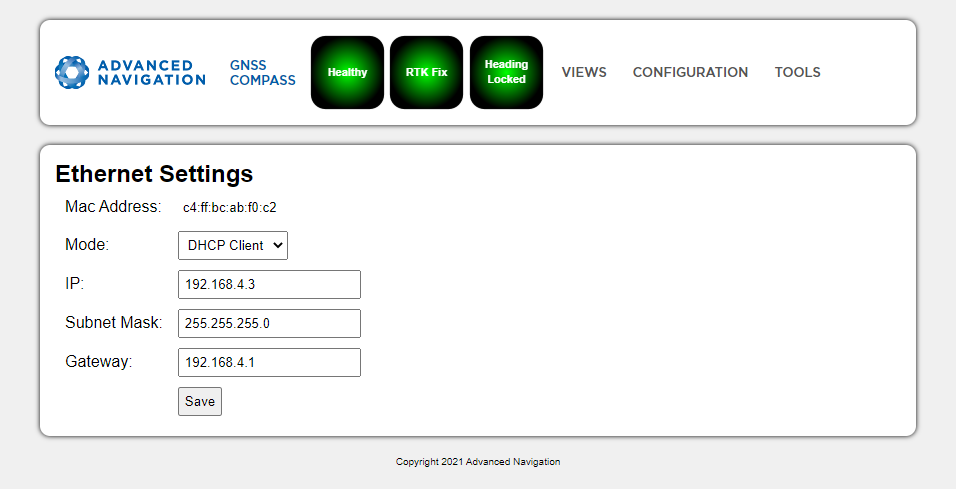
GNSS Compass Web UI Ethernet Settings page
NTRIP Client
The NTRIP client built into GNSS Compass can be used to connect to a network DGPS (Differential GPS, a older standard for GNSS corrections of lower performance than RTK) or RTK service to stream correction data to GNSS Compass for DGPS or RTK. The NTRIP client requires that GNSS Compass has an available internet connection to the NTRIP Caster to function.
The source of the corrections data can be either your own base station, configured as an NTRIP Caster, or a third-party service. Either way, you will need the login details for connecting to and authenticating with the NTRIP Caster, and identifying the nearest mountpoint.
These steps are required:
- Select Enabled.
- For Host/Server, enter the NTRIP Caster address.
- For Port, enter the NTRIP Caster port numbe. This is usually 2101.
- Click Save.
- Click Get Mountpoints.
- Select your mountpoint from the Mountpoint drop down list, being mindful that the distance should not exceed 50km.
- Enter your username in the Username box.
- Enter your password in the Password box.
- Click Save.
To disconnect from the NTRIP Caster unselect Enabled and click Save.
Troubleshooting NTRIP Caster Connections
If you cannot get the list of mountpoints, ensure the Host Address and Port number are correct for your NTRIP Caster.
If the Connection Status is not green, and says UNAUTHORISED this indicates an incorrect username or password.
Contact support@advancednavigation.com for further assistance with network DGPS or RTK.
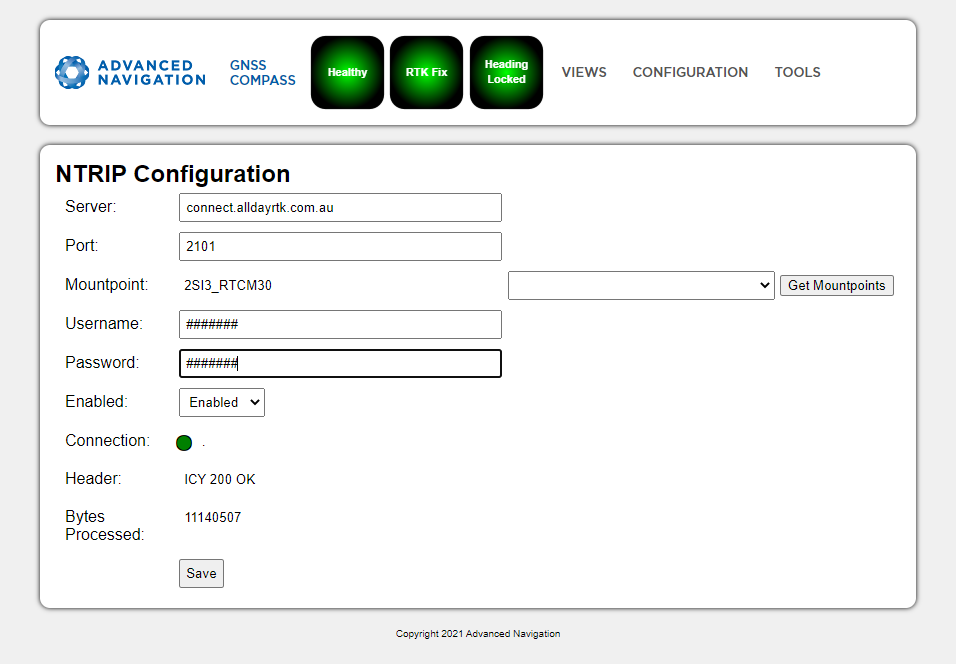
GNSS Compass Web UI NTRIP Client Page